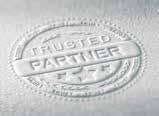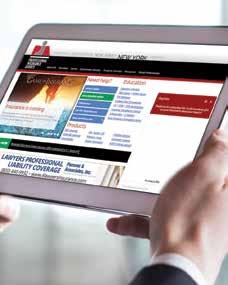








» Attain an enterprise risk-management skill-set via a
» Immersive, cohort-based, online microlearning modules
» Self-paced flexibility—Each module is 30-45 minutes a day, for five days
» Earn the TRA designation in four months—no tests or annual update
TRA 1
Sept. 16-20
Goodbye, Agent and Broker. Hello, Trusted Risk Advisor
Webinar finale: Oct. 1
TRA 2
Oct. 15-22
The Art and Science of Discovery … Leading to Strategy
Webinar finale: Oct. 29

TRA 3
Nov. 12-18
The Risk Advisor … Moving Away from the Transactional Sale
Webinar finale: Nov. 25
TRA 4
Dec. 2-6
MEMBERS SAVE 45% ON CERTIFICATION PACKAGE. PIA has partnered with Beyond Insurance to deliver the Trusted Risk Advisor Certification Program at a reduced rate with your PIA membership.

Creating a Differentiated Customer Experience Journey through the TRA Process
Webinar finale: Dec. 17


September 2024 • New Hampshire
20 The year-round wildfire season
Help your clients manage a possible new threat
Make sure your clients have the right coverage for their possessions
Statements of fact and opinion in PIA Magazine are the responsibility of the authors alone and do not imply an opinion on the part of the officers or the members of the Professional Insurance Agents. Participation in PIA events, activities, and/or publications is available on a nondiscriminatory basis and does not reflect PIA endorsement of the products and/or services.
President and CEO Jeff Parmenter, CPCU, ARM; Executive Director Kelly K. Norris, CAE; Communications Director Katherine Morra; Editor-In-Chief Jaye Czupryna; Magazine Advertising Sales Representative Adam Wolfe; Senior Magazine Designer Sue Jacobsen; Communications Department contributors: Athena Cancio, David Cayole, Jeana Coleman, Patricia Corlett, Darel Cramer, Matthew McDonough and Damon Whimple.
Postmaster: Send address changes to: Professional Insurance Agents Magazine, 25 Chamberlain St., Glenmont, NY 12077-0997.
“Professional Insurance Agents” (USPS 913-400) is published monthly by PIA Management Services Inc., except for a combined July/August issue. Professional Insurance Agents, 25 Chamberlain St., P.O. Box 997, Glenmont, NY 12077-0997; (518) 434-3111 or toll-free (800) 424-4244; email pia@ pia.org; www.pia.org. Periodical postage paid at Glenmont, N.Y., and additional mailing offices.
©2024 Professional Insurance Agents. All rights reserved. No material within this publication may be reproduced—in whole or in part—without the express written consent of the publisher.

Vol. 68, No. 8 September 2024


Wildfires, the unplanned burning of an area of wilderness, are a devastating natural disaster. While wildfires aren’t as deadly as other natural disasters, they still claim many lives and devastate human-made structures, displacing thousands of people and costing millions of dollars in damage. Wildfire season lasts from summer to fall, leaving a wide window open for this natural disaster.
There are several factors involved in the ignition and spread of a wildfire. First, conditions must be dry and hot enough in a vegetated area: under these conditions, grass, trees, brush and other vegetation turns into kindling.

Second, comes a spark. Most wildfires are ignited by lightning strikes, but they also can be caused by wayward sparks, human action (e.g., arson, camping accidents), or even volcanic activity.
Third, once a wildfire gets going, it can be difficult to stop. Wind can increase the spread of the fire, carrying embers, smoke, or driving the flames, and a lack of rain can further prolong these disasters.
According to the National Interagency Fire Center
in 2023, 56,580 wildfires burned 2,693,910 acres in the U.S. Since 1983, the United States has averaged 70,000 wildfires per year. in 2022, there were 68,988 wildfires in the U.S. in 2017, there were 71,499 wildfires in the U.S.
Luckily, the standard homeowners policy covers fire damage, including damage from wildfires. Based on the clients’ proximity to a wooded area and weather trends in their region, you may want to talk to them about increasing their coverage limits in the event of a major wildfire.
Alongside wildfire insurance coverage, clients can take steps to protect their houses so they can weather the disaster better. This includes removing debris from the property, using fire resistant materials on the house, keeping the yard hydrated and pruning trees. The less flammable material, the better.
Like many natural disasters, clients can’t up and move their houses out of the path of wildfire. To keep clients safe, encourage them to follow evacuation orders and consider leaving before the last possible minute.
For those individuals living in the American Northeast, their familiarly with wildfires may be relegated to the blazes along the West Coast. However, as climate change creates drought conditions across the globe, the Northeast may be more susceptible to more devastating fires going forward.
For instance, a wildfire in the New Jersey Pine Barrens in 2022 consumed roughly 13,500 acres, making it one of the largest fires in the Pine Barrens and sending smoke across the region.
The 2023 Canadian wildfire season was far more dramatic, consuming 11.91 million hectares according to the Canadian Interagency Forest Fire Centre Inc., which blanketed Canada and the Eastern seaboard in a thick haze. The only comparable seasons include the 1989 wildfire season (burning 6.04 million HA) and the 1995 season (7.1 million HA).
Drier and hotter conditions across the Northeast are laying the conditions for massive blazes. Don’t get caught off guard —start having conversations with your clients now about this potential risk.

If your agency was hit by a hurricane, earthquake or large fire, would you have a plan to respond and continue business? Do you and your staff know what to do in case of a physical attack on your office, such as an active shooter? What about your agency’s succession plan? Thinking about these occurrences ahead of time could save the lives of your employees and your agency money.
What will you and your employees do in the event of a hurricane? Earthquake? Chemical spill? Bomb threat? Or flood? You need a response plan in place for these disasters and events.
As we learned from the COVID-19 pandemic, this plan should include how you respond to the emergency, what employees should do, as well as how you will continue business after the immediate emergency is over (especially if your building is without power or you are unable to access it for a few days or weeks). How will you answer client calls or emails and how will you continue to process claims or write new business if you are unable to get back into your office?
Once you have created the plan, make sure all employees know what it is and what is expected of them. Certain individuals should be responsible to ensure everyone is accounted for in an evacuation, while others should oversee alerting the proper authorities (much like you would call the fire department in the event of a fire). You should have a diverse group of employees from various levels of your agency be part of a workgroup that periodically reviews the plan and makes updates if needed.
Active-shooter preparedness
According to a report issued by the FBI, there were 48 active-shooter incidents in 2023 in the U.S. Of those, 14 (29%), were in areas of commerce. This demonstrates that a fair number of mass shootings do not occur at malls and schools where there are large numbers of people; it could happen in a business just like yours. Are you and your employees prepared for such an event?
The best time to think about what to do in the event of an active-shooter incident is before it happens. The first thing to do: hold active-shooter training for your employees; your local police department probably offers this training for free. This training will provide you with tools to help you prepare for an active-shooter event, as well as how to respond if you ever find yourself in such a situation.
The Federal Emergency Management Agency, the Department of Homeland Security and the Red Cross have resources to help you prepare for an active-shooter incident at your workplace including training, preparedness videos and other planning materials.
A succession plan is just that—a plan for who will succeed current leaders in your agency. Planning should start as soon as possible; identify employees who show promise and begin to train and mentor them. Even if you don’t think you will need a replacement anytime soon, succession planning is based upon the knowledge that employees will not be with an agency forever; they either will retire or leave for a different opportunity.
While you are identifying current employees who might move up, this can impact your overall hiring strategy. Who might be a good replacement for the people you want to see move up to management when they are promoted? In this way, succession planning is not just about preparing people to move into the highest positions in your agency, but how you plan for your entire agency to continue to function as a whole, because when Sally gets promoted to manager, someone has to take her place.
One way to identify and mentor these employees is through a company-sponsored mentorship program. You can match upper-level employees with middle- and lowermanagement employees to help them improve in areas they identify (e.g., interpersonal communication, technical skills or supervisory skills).
This program will improve your workforce, and it is an opportunity for you to identify who is willing to work on themselves and who shows promise for advancement and leadership in your organization.
Just as you may have a plan in the event of a fire, you need to plan for disasters—both fabricated and natural— and for the continuance of your agency. When you are in an emergency, or find you have five people retiring all at once, these are not the times to think about a plan.
There is no one-size-fits-all approach to any disaster or succession planning, so your plan will differ from other agencies, but hopefully this information gets you started thinking about your level of preparedness.









As an insurance agent or broker, helping clients choose the right flood insurance is crucial—especially when they face the aftermath of a flood.
Understanding the distinctions between the National Flood Insurance Program and private flood insurance is essential for guiding clients effectively.
The NFIP was created by Congress in 1968 and is administered by the Federal Emergency Management Agency. It provides flood insurance to property owners, renters and businesses in participating communities that adhere to FEMA’s floodplain management regulations. The NFIP offers policyholders coverage of up to $250,000 for residential buildings and $100,000 for contents. For commercial properties, it provides up to $500,000 for both
Our new homeowners program offers:
• Broad Availability
• Instant Quotes
• New Discounts
• 34 Years of Friendly Service and Local Expertise
Start quoting Plymouth Rock today!
buildings and contents. The NFIP aims to offer essential flood insurance coverage, ensuring that even those in high-risk areas have access to necessary protection. However, its standardized coverage limits and requirements can sometimes be less flexible compared to private insurance options.
The standardized nature of NFIP policies means that while they provide a baseline level of protection, they might not offer the customiz-

able options that some policyholders need. This can be particularly relevant for those with unique property situations or higher-value assets. Agents should make sure clients are aware of what an NFIP policy does and does not cover, as this can help set proper expectations and avoid potential misunderstandings during the claims process.
Private flood insurers operate independently of FEMA, offering customizable coverage tailored to meet individual needs with more flexibility. Marketdriven premiums can lead to more competitive pricing by accurately reflecting the unique flood risk of each property. These carriers often provide additional benefits such as coverage for temporary living expenses if a home is uninhabitable or more extensive coverage for personal property, which an NFIP policy does not cover.
Private insurers are not bound by the same regulations as the NFIP, which allows them to offer a broader range of coverage options. This flexibility can be beneficial for clients who require specific coverage that the NFIP does not provide. The ability to tailor policies to fit individual needs can result in better protection and potentially lower premiums for clients, depending on their specific risk factors and insurance requirements.
Understanding the claims process for both NFIP and private flood insurance is vital to assisting your clients effectively. Here’s a step-by-step guide:

No. 1: File the notice of loss. Promptly submit a written notice of flood-related damage to the insurance carrier, including the policy number. Encourage clients to act quickly to ensure their claims are processed in a timely manner.
No. 2: Separate the insured property. Advise clients—in writing—to separate damaged from undamaged property to protect the latter. Move undamaged items to a safe, dry area. Emphasize the importance of photographing all damaged items before discarding them—unless they pose a health or safety risk, or local law requires disposal. This documentation is crucial for supporting the claim and ensuring that clients receive appropriate compensation for their losses.
No. 3: List and photograph personal property. If they have contents coverage, assist clients in creating a detailed list of all damaged personal property. Include descriptions, quantities, brand names, purchase prices, sizes, and any other relevant details along with photographs. Having a thorough, documented, personal inventory will help expedite the claims process and ensure that nothing is overlooked.
No. 4: List and photograph structural damage. Guide clients to document and photograph all structural damage, such as cracks, sagging floors, or hard-to-open doors and windows. This step is vital for substantiating the extent of the damage and supporting the claim.
No. 5: Contact the adjuster. Within a day or two after receiving the notice of loss, an adjuster will contact the client to start the claims process. Help clients schedule a time for the adjuster to inspect the property. Preparing for this visit by having all documentation and answers to ques-
tions ready can facilitate a smoother inspection process.
No. 6: Inspection and scoping. During the inspection, the adjuster will take measurements, photos and notes about the damage. Be available to assist in preparing an inventory of damaged items if required. Explain to clients that the adjuster’s role is to assess the extent of the damage and that their cooperation is key to a comprehensive evaluation.
No. 7: Request advance or partial payment. Inform clients that they can request an advance or partial payment to begin recovery before the insurer settles the full claim. Note that if there is a mortgage, the mortgage company must sign all building payment checks. This advance can help clients start repairs and replacements more quickly, alleviating some of the immediate financial burdens.
No. 8: Request additional payment. If additional damage is discovered during the claims process, clients can request an additional payment within the 60-day limit or within any granted extensions. Ensure clients notify the adjuster and provide necessary documentation, including a written Proof of Loss and a contractor’s detailed estimate of costs. Remind clients to keep all receipts and documentation of repair costs to support their claims.
No. 9: File an appeal. Clients can file an appeal directly with FEMA if their claim is partially or fully denied. Emphasize that there is no cost to file an appeal and no need for thirdparty representation. Appeals must be filed within 60 days of the insurer’s denial letter. Providing guidance on how to prepare a comprehensive appeal, including necessary documentation, can be instrumental in achieving a successful outcome.
By consulting with you, their independent insurance agent or broker, and following these steps, clients can navigate the flood insurance claims process smoothly and confidently. Whether they have an NFIP or private flood insurance policy, your guidance will ensure they are well-informed and prepared.
Regular communication and support throughout the process will help clients feel more secure and assured that they are making the best decisions for their recovery and protection.
Alexander is PIA Northeast’s government & industry affairs specialist.








Agencies around the country are reporting a wide range of issues due to the hard market—including increased premiums, reduced capacity, restrictive policy terms, and stricter underwriting from the carriers. How an agency deals with the hard market affects its bottom line. Here are several best practices to note:
No. 1: Provide proper staff training. Counsel your agency staff on how to deal with clients who may be experiencing large rate increases or coverage reductions.
No. 2: Deal with more restrictive policy terms. Communicate to your insureds that they may see changes to coverage and they should review their renewal terms carefully. Tell insureds you can assist them with securing alternate terms if you have alternative markets available.
Communicate in writing to your clients about what their upcoming renewals will look like and what they can expect in the way of pricing and coverage terms. It’s better to be general than specific. Explain that they should expect changes, review renewal terms carefully, and reach out to you if they want to discuss the changes or pursue terms through other markets. If you note specific



• Travel Agents and Travel Agencies
• Standard Tour Operators
• Student Tour Operators
• Adventure Tour Operators
• Receptive Tour Operators
• Destination Management Companies
• Meeting Planners (Corporate)
• Worldwide Territory
• General Liability
• Errors & Omissions
• Non-owned & Hired Auto
• Personal Injury
• Industry specific endorsements
changes to an account, it’s possible to miss something that could become an errors-and-omissions claim.
If you are presenting the renewal terms to your clients, note any coverage changes to them in writing when providing the quote.
Keep in mind that while admitted carriers generally will need to give notice when they are reducing coverage, excess- and surplus-lines carriers are not required to do so. You might find a new exclusion or coverage change when you receive the renewal proposal, leaving you with little time to secure alternatives. Be proactive about asking your wholesalers/E&S carriers what type of policy coverages to expect on renewals. Do not assume they will point

Now offering a revised “Lethal Weapons Exclusion” form for qualifying insureds.
• Exceptional service is an EverGuard priority
• Uncompromised program loyalty
• Available A&B, Enhancement Endorsement & more
• No limit on alcohol sales
• Package Policy: Property, GL & Liquor Liability
• Entertainment considered
• Experienced & Professional Staff
EverGuard is a superior Restaurant, Bar & Tavern market with 40+ years’ experience. Your RBT clients can depend upon EverGuard for their protection.
Our continued longevity offering an uninterrupted market assures you will receive the best product underwritten by an A.M. Best “A” rated carrier without program interruptions. EverGuard’s respected reputation in the RBT market speaks to our stability and reliability to provide industry leading response time and customer service to our partner agencies.
EverGuard Insurance Services
1900 W. Nickerson St., Seattle, WA 98119
Visit EverGuardins.com for a listing of the states the program is available. EverGuard does not offer or solicit the program in the states of Connecticut, New Hampshire, or Vermont.

Michael Maher
EverGuard Insurance Services
VP, Business Development
Michael@everguardins.com
206.957.6576
www.everguardins.com
out any changes to terms on the renewal quote—review these carefully for changes.
Remember: When using wholesalers, you don’t want to assume. Effectively using the wholesale marketplace includes knowing that it has some uniqueness that agents must understand and account for. Putting specific processes and procedures into place can help minimize the potential E&O problems. Wholesalers are a key segment of the industry. Due to how wholesalers do business and the potential differences among wholesalers, agencies must be aware of these differences and not assume that all wholesalers are the same. Dealing effectively with your wholesalers can be a crucial issue to minimize your E&O exposure. The following tips can help: Get the application. The markets some wholesalers are willing to quote are based on a standard generic application, while others might require a specific carrier application. Know this information up front to avoid any potential delays. Wholesalers often navigate a high volume of accounts, which may impact their turnaround time and may not have the flexibility to backdate coverage if terms are not secured before the renewal date. Review the application when you receive it from a client and address any incomplete information or obvious discrepancies prior to submitting it to the wholesaler to ensure the account can be quoted in a timely manner.
Be diligent in your follow-up with your wholesalers. The last thing an agency wants is to get the proposal the day before the coverage will be effective. This time frame may not allow the agency to review the proposal and to note any pertinent
issues/coverage exclusions or limitations.
Review proposals from wholesalers for any differences. When the agency sends in an application to various wholesalers, it is common for there to be a difference in the coverages. Analyze proposals and note any differences. Offer clients multiple proposals to enable them to choose. Clearly know binding requirements. Procedures and expectations to bind likely differ between wholesalers. For example, say you want to bind a risk on a Friday, at 4 p.m. Can you do it or will the wholesaler advise you that it needs payment and necessary affidavit forms before it can bind? Clearly know the rules of engagement when working with wholesalers—and factor these rules into your handling of the risk. Look for wholesalers that will provide you with an account current for your business. This will take away some of the potential headaches.
Don’t assume that coverage is bound. Your retail agency is not an agent for the markets accessed through the wholesaler and, therefore, you do not have binding authority. Do not advise your client that coverage is bound until you receive confirmation from the wholesaler that it has been bound.
Don’t assume the policies are correct. Policy issuance in the industry continues to be a significant area of concern—some agencies cite that there is at least one error on every policy they receive. Check policies to determine if they have been issued per the agency’s instructions.
Remember that the wholesaler may not have all the facts. Essentially, wholesalers are only handling a specific issue, a specific coverage.
Do they know the entire story of the account? No. For example, with personal umbrellas, there is a requirement regarding the amount of the underlying coverages (e.g., auto, homeowners, boat). When an agency asks the wholesaler to write a personal umbrella, the wholesaler will provide a proposal that probably stipulates what those underlying limits need to be. A standard market may follow up on this issue, but there is no guarantee a wholesaler will.
No. 3: Handling client requests to reduce coverage/limits. Document and memorialize discussions with clients when they look to reduce their limits or coverage to counteract the price increases they are experiencing. Note these discussions in your agency file and back to the customer by email or letter.
No. 4: Moving coverage to a new carrier. Compare the expiring coverage and the proposed replacement coverage and bring any differences to the clients’ attention. Supplying the insureds with specimen forms and encouraging them to read their policy also are strongly suggested.
The hard market affects virtually every agency. The better prepared your agency is for all the issues you will face will determine to what degree your agency is affected.
Utica National Insurance Group and Utica National are trade names for Utica Mutual Insurance Company, its affiliates and subsidiaries. Home Office: New Hartford, NY 13413. This information and any attachments or links are provided solely as an insurance risk management tool. They are derived from information believed to be accurate. Utica Mutual Insurance Company and the other member insurance companies of the Utica National Insurance Group (“Utica National”) are not providing legal advice or any other professional services. Utica National shall have no liability to any person or entity with respect to any loss or damages alleged to have been caused, directly or indirectly, by the use of the information provided. You are encouraged to consult an attorney or other professional for advice on these issues.© 2024 Utica Mutual Insurance Company




Brooks Insurance Agency is proud to support Professional Insurance Agents (PIA)
Since its founding in 1991, Brooks Insurance Agency has successfully serviced the standard markets and brokered distressed and complex lines of business. We are here to help agents find the coverage their clients need.
We represent 80+ quality carriers, including several new and exciting markets, across the country. Plus, a broad array of products and services in admitted and non-admitted markets.
MARKET STRENGTHS AND EXPERTISE
• Broad market reach
• High-touch broker specialists
• Easy, online quoting process
• Collective approach to complex insurance needs
Visit our website at www.brooks-ins.com.
Brooks Group Insurance Agency, LLC NJ License 1575143
BROOKS IS YOUR FULL-SERVICE WHOLESALER
How can we help you? Call us at 732.972.0600 or email us at info@brooks-ins.com

Help your clients manage a possible





LARRY CHASIN CEO, PAK Programs
Until recently, wildfires followed a seasonal pattern. Primarily, we saw dangerous wildfires spread through the summer and fall months, and then a cooler period during the winter and spring when businesses countrywide would have the opportunity to rebuild and recover. After the unremitting fires from 2017 to today, we now can consider wildfires to be a year-round threat.
Independent agents who want to protect their clients from this threat need to understand wildfire risk and share best practices with clients to mitigate against it.
Just this February, the Smokehouse Creek Fire devastated large swaths of Texas. The winter fire burned an estimated 1.1 million acres across the state, making it the largest wildfire to ever hit Texas and one of the largest to ever hit the U.S.1
Similarly, in December 2017, the Thomas Fire ravaged California. The fire burned over 280,000 acres of land in the area and took down over 1,000 structures.2 The damages and subsequent mudslides the fire caused led Southern California Edison to pay out roughly $1.2 billion in insurance claims.3
Spring and Fall—the more traditional wildfire season—continued to pose a strong threat as well in recent years. In July 2021, the Dixie Fire burned nearly one million acres of California land,4 cost $637 million to suppress and destroyed nearly 900 buildings.5 The fire served as a significant setback to small-, medium- and large-sized businesses in the region and it took years to recover fully.
Finally, just last August, the Maui Wildfires led to an estimated $3.08 billion in insurance losses and estimates predict that number to reach around $5 billion.6 The fires also claimed around 100 lives and the area still is recovering from the damage to infrastructure.7
While wildfires may not be as frequent or potent of a threat in the Northeast, they still are important to keep in mind as agents manage clients in highseverity niches. In Massachusetts, the Berkshire Wildland fire in 2021 burned roughly 800 acres and required more than 120 firefighters to subdue.8 More recently, in 2022, the Bemis Fire in New Hampshire burned more than 100 acres of land.9
Without proper preparation businesses in the Northeast also could face severe consequences if they are not adequately prepared when a wildfire ignites. And with the unpredictability of climate change, agents need to keep their clients prepared as wildfire at-risk regions could shift and damage new areas that are not used to managing fire risks.
With devastating wildfires no longer following a seasonal pattern, how can independent agents best assist their clients at risk of wildfire damage?
From 2017 to 2020, wildfires caused $37 billion in insured losses across California alone, affecting homes, farms, ranches, wineries and more. As a specialty program administrator in the winery space, we have seen wildfire devastation firsthand. Many wineries were put out of business by fires that ravaged their expansive properties and destroyed their supply. Many that are still in business continue to feel the impacts of the past decade of fires. While different businesses face different risks, the lessons learned in the winery industry can serve as a valuable case study for agents to share with their clients to improve risk-mitigation efforts of their own.
Consider these two scenarios and the takeaways they present:
We visited a winery in the Alexander Valley region and performed a thorough risk analysis using our drone imagery, 3D modeling and general walkthrough data. Our analysis found there was a barn and small dwelling on the property that were at a high level of risk. The barn had poor defensible space, large attic eaves and stacks of grape-collecting bins piled next to it, which all make for potent fire fuel.
After the visit, we recommended the winery cut back tree limbs and brush around the barn and dwelling, as well as also replace the ¼" eaves on the dwelling with ⅛" mesh. The goal was for the renovations to protect the building in the event of flying embers caused by a fire.
Later, we learned the winery had not followed all our recommendations. Soon after, the Kincade Fire barreled through the area burning more than 77,000 acres and destroying 374 structures.10 Strong winds blew embers from the fire into the Alexander Valley. The dwelling quickly caught fire and the convective heat from the building caused the stacks of grape bins to melt and smolder. The bins then ignited, which set the barn on fire. The winery suffered costly losses and shut down for a significant period as it managed the rebuilding efforts.
In a separate instance, we visited a client in Napa Valley and offered recommendations to improve its defensible space. These recommendations included methods to manage the vegetation and brush, and to clear trees. The insured worked with a local arborist to start this process. When we followed up six months later, we found not all the work had been finished. Upon our reminder,
the insured immediately contacted the arborist and had the changes made. In 2020, the Glass Fire tore through Napa Valley, but spared our insured’s property. It only burned around the buildings, but no structures suffered direct damage thanks to the risk-mitigation efforts.
Independent agents who want to establish themselves as the best advocate for their clients during wildfire season should take active steps to establish their knowledge base on wildfire mitigation, particularly as it relates to a client’s unique needs. Partnering with the right carrier or program administrator can make a significant difference in helping business owners understand their particular risk exposures and how to best protect against them.
A specialty insurer will know the full range of risks that clients in a certain niche face on a regular basis. For example, in the winery space, independent agents should partner with a winery insurance specialist that understands the right defensible space counsel to provide, how to communicate with winery clients on changes that need to be made to their property and other winery specific technology or resources that clients can utilize to protect themselves from a wildfire.
With that in mind, agents should work to gain a foothold in a particular specialty. In a difficult economic market, specializing can be a strong tactic for growing your book of business and finding new clients.
A boots-on-the-ground approach continues to be essential in our industry. While technology has made remote risk management more possible than ever before, nothing can replace the value of communicating with a client in person. Visiting a client’s property can highlight critical risk exposures the client may not notice, and it also offer agents the opportunity to ensure their client is insured properly for all structures and inventory on-site. This will reduce the chance of any sticker shock in the event of a loss from a fire.
During these site visits, agents should discuss disaster planning with their clients. All businesses should have a disaster response plan in place, with specific fire response instructions. The plan should include best practices and protocols for how to act in the event of a fire, evacuation routes, how to secure and protect equipment and more. Management also should have a commu-









Keep these addresses handy to reach PIA
electronically General pia@pia.org
Conference conferences@pia.org
Design + Print design.print@pia.org
Education education@pia.org
Government & Industry Affairs govaffairs@pia.org
Industry Resource Center resourcecenter@pia.org
Member Services memberservices@pia.org
Publications publications@pia.org
Young Insurance Professionals yip@pia.org
nication plan in place for staff, customers and vendors so everyone can be prepared to move forward in the event of a loss.
Communication and helping a client understand the appropriate safety practices also can make all the difference for a business facing a wildfire. This communication should include discussions on: Managing defensible space. Controlling vegetation and landscaping in the area surrounding the property will reduce the fire fuel on-site and make it more difficult for it to spread throughout the entire business.
Implementing fire-resistant building materials. Upgrading to fire-resistant roofing, siding and windows can reduce the risk of a structure catching fire significantly. This includes using materials like metal, slate, or tile for roofing and choosing double-paned or tempered glass windows. Replace attic eves and intake mesh with ember grade ⅛" wire.

Creating a fire action plan. Ensure that the business has a comprehensive fire action plan, which includes regular fire drills, clearly marked evacuation routes, and designated meeting points for staff. This plan should be reviewed regularly and updated to accommodate any changes in the business layout
Wildfires continue to serve as a significant obstacle to society, as well as the insurance industry. While the threat may not be as catastrophic in the Northeast, agents looking to grow their business and support their clients should know how best to counsel their insureds on wildfire risk mitigation. Taking the time to understand the full range of threats of a wildfire, working with the right business partners and getting educated in the right safety practices can help agents position themselves as the ideal business partner when
Chasin is president and CEO of PAK Programs (www.pakprograms.com), which provides insurance programs for wineries, vineyards, breweries, wine & liquor retailers, cideries, meaderies, distilleries, liquor & wine importers and distributors. He can be reached at larryc@pakprograms.com.
Western Fire Chiefs Association, 2022 (tinyurl.com/yc5vbueh)
, 2018 (tinyurl.com/59cmsynf)
Los Angeles Business Journal, 2022 (tinyurl.com/5y88k3ay)
CalFire, 2022 (tinyurl.com/j6pubzph)
AP, 2021 (tinyurl.com/2p4amnd2)
, 2024 (tinyurl.com/5y3mrhxe)
, 2024 (tinyurl.com/ydum5cad)
MassLive, 2021 (tinyurl.com/yjjkytzr)
WMUR, 2022 (tinyurl.com/2e47z7a7)
Courthouse News Service, 2024 (tinyurl.com/262tuc5d)
DAVID BRILL Marketing/contents specialist, PaulDavis

Disasters can strike our clients at any time, in any form. They can be as devastating as a house fire, or as mundane as a broken water pipe. No matter how they occur, clients will want to assess the damage quickly, and they will want to get back to their normal routine as quickly as possible.
Whether they can do so depends on the conversations they have with their insurance professionals prior to the unfortunate event. Do you know the types of conversations you need to have with your clients to allow them to work with a restoration service to clean, repair or replace their beloved possessions?
When we walk into a home to speak with clients, typically their first question is: “How long is this going to take—when will we be back into our home?” Usually, their second question is: “What about my stuff—are my things going to be OK?”
Whether from a fire, a water loss or a mold issue, we often can tell the homeowner that we need to gut half the
house, but they’re going to get a new kitchen, new paint, new floors, etc. Usually, they’re fine with that statement. Some folks are even gleeful at the prospect of getting a new home.
As soon as we tell them that we need to move all their belongings out, it’s a different story. We start to hear statements, such as: “Great Grand Pa built that desk and the china in the hutch came over with great, great Aunt Elda on the Mayflower. Oh my God, no, is it going to be OK?”
Peoples’ contents mean much more to them than the sheet rock and framing that make up their house. The lumber, sheetrock, plumbing, paint and tile make a house, the owner’s contents and the sentimentality attached to their possessions, make a home.
After a fire, where it’s easy to tell that contents have been affected, many times, the clients feel that everything is destroyed—it’s all black, covered in soot, the house smells. They think: “How can anything be savable?”
The answer is: Technology.
Ultrasonic cleaners, specialized solutions, hydroxyl and ozone generators—all of these tools are used to remove the soot and the odor and return the contents to pre-loss conditions. If an item is just a little too far gone for our standard processes, furniture refinishing is an option. However, even with all the technological advancements, there are items that cannot be returned to pre-loss condition, and these items are considered unsalvageable or totaled.
There is quite a bit of science that goes into deciding what can be cleaned/ restored and what can’t. The algorithm is based on what burned (e.g., wood, sheetrock, plastics, clothing) as each substance creates its own type of soot that requires a specific cleaning method and/or solution.
When contents have been affected by water, they may just need a quick wipe off, or sometimes they need full restoration/refinishing. If they’ve been in a damp environment for a long time, they may have mold growth. This can be removed with a combination of HEPA—high efficiency particulate air— vacuuming and cleaning with an antimicrobial solution. Contents that have been allowed to sit in this kind of environment for too long though may become unsalvageable as the mold spores literally feed on the substances, causing them to eventually weaken and fall apart.
As much as what happened to the contents matters, what the contents are made of matters quite a bit, as well.
Solid wood furniture can withstand a lot of damage and there are many ways to treat it to return it to its pre-loss condition. Whereas, laminate furniture cannot take the same punishment, and it often may not be worth the time and energy it takes to attempt to clean/restore it. So, listing the item as unsalvageable is the most cost-effective choice. Plastics and cloth/textiles all require different restoration techniques, and they need to be approached differently.
It’s difficult to put into words the devastation we see on homeowners’ faces when they find out their insurance policies won’t cover certain aspects of their prized possessions.
Some clients don’t have enough overall coverage, and we need to cherry pick what items can be saved to stay within their policy limits. Or worse yet, the totaled items will surpass their limits and the items we can clean/restore end up getting thrown away without any compensation.
Other times certain aspects of the contents may not be covered or have limits, such as collections (e.g., baseball cards, die-cast cars, watches, stamps) jewelry, electronics and more.
Data transfer or data retrieval from laptops and computer hard drives, and other devices like PlayStation consoles, tablets, and phones isn’t an overly complicated restoration process. However, it does take time. And, some insurance policies don’t cover it all—or the expense is part of the client’s electronics coverage, which often is set at $2,000 by many insurance companies—unless it is increased by the client and his or her insurance agent.
Another aspect of contents insurance that gets confusing is when the policy is for a condominium or a renters insurance policy.
I can’t tell you how many times we’ve been called to handle a claim, and the condo owner or renter has little coverage because he or she didn’t understand how insurance in a multifamily dwelling works. With an association deductible of $10,000 to $20,000 and some contents coverage, many condo owners think they have $25,000 of contents coverage. In reality, they have a $20,000 association deductible, and $5,000 in contents coverage, which is woefully inadequate.
When I’m asked about the kind of contents coverage someone should have for a condo—or even a standard home—I tell them they should have no less than an average of $15,000 per room, which includes bathrooms, basements and attics.
A standard Cape Cod style home, with two bedrooms, a dining room, living room, kitchen, one bath, an attic and full basement should have a bare bones minimum of $120,000. However, often contents coverage is a percentage of the home coverage, a Cape Cod style home with $320,000 of building/structural coverage generally would allow for about $250,000 of contents coverage.
In a condo or apartment, the percentage doesn’t apply, so clients need to be walked through the process, and they need to answer questions about their possessions. Independent insurance agents need to explain that adding additional coverage generally won’t break the


bank. Clients also need to be told that they are responsible for their contents—regardless of who is at fault for the damage. If the renter in the unit above the client starts a fire or leaves the water on in the tub and leaves the house, that person’s insurance is not going to pay for the client’s contents—the client must have his or her own coverage.
Of course, getting the details from your clients lets you sell them the proper product at the correct limits. The $250,000 mentioned previously in this article may be more than adequate for some, while for others it could be a shortfall. The TV show Hoarders showcases instances of extreme hoarding, but there are a lot of people out there who have a lot of stuff, and they still need the right amount coverage. Artwork, large amounts of contents in the home,
Before-and-after photos of how possessions can be restored to pre-loss conditions. Photos courtesy of PaulDavis.


specialty electronics—all of these are areas in which you can assist your clients in getting the correct coverage.
Another aspect that clients often struggle with understanding is actual cash value verses replacement cost value and depreciation. When working with your clients, going over these aspects may seem like overload in a confusing process. However, a little extra time spent here can avoid heartbreak down the line when they realize they don’t have enough or proper coverage.
In summary, you are the licensed insurance professional with the knowledge and experience to help people set up the correct insurance so that if they suffer a loss, they are covered fully and properly, and they won’t have to suffer any more than dealing with the claim itself.
Ask the questions that will allow you to prepare a complete insurance policy that will allow your clients to get back to pre-loss condition. Afterall, people don’t care how much you know until they know how much you care.
Brill has been in the restoration industry for over 25 years. He started as a basic technician working on fire and water losses for one of Connecticut’s first full-service restoration companies. He received his Institute of Inspection Cleaning and Restoration Certification’s fire restoration, odor removal, specialty carpet cleaning and electronic restoration certifications. Additionally, Brill is a level 3 Xactimate estimator. Since 2020, he has worked for PaulDavis New Haven County and Shoreline East, where he started a contents department that grew from $300,000 in revenue to over $1 million in two years, and he works in the company’s marketing department.







JOHN CHAPIN President, Complete
Many of the most successful salespeople are not Rhode Scholars and they don’t possess particular talents or gifts. Some might say, “Well, wait, they have the gift of gab. That’s a talent.” Yes, some do, but many do not, and many are introverts who are not super-comfortable on the social scene. That said, they still are successful. The reason being is that a lot, if not all, of the most important sales success traits don’t require you to be a member of Mensa, nor do they require you to be a born socialite equipped with a silver tongue. So, what are these key success traits that almost anyone from any walk of life can have? Keep reading.
You can work as hard as you want, and you can put in as many hours as you decide. The most successful people in any field are the hardest workers. They may not be the hardest workers in advanced evolutions of their careers, but they were when they were just starting out and building their business.
You can decide to have courage and resolve, and be resolute in your desire to go through whatever you must go through to come out successfully on the other side.
You can decide you’re going to stay positive and have a good attitude no matter what. Sure, this may take some work—especially if you tend to be negative— but ultimately, your attitude is up to you.
We don’t always have complete control over our feelings, and our thoughts can take some practice to completely control, but the one thing we always have control over is our actions. For salespeople it’s doing enough of the necessary sales activities.
This is the long-term version of grit. It is continuing the course no matter how much hardship there is and how long it takes. Success does not come
overnight and there is a lot of rejection and failure—especially at the beginning of a sales career. However, if you press on no matter what, you’ll eventually come out the other side a winner at whatever you do.
You decide whether you follow through both on tasks assigned directly to you and those you’ve passed off, to ensure they get done. You also decide how many times and how you follow up with someone. Most salespeople don’t follow up nearly enough.
This is doing the right thing, all the time. This is not making sales that shouldn’t be made. In other words, not making money at the customer’s expense. This is doing what you say you’ll do when you say you’ll do it. This is being a person of your word and keeping the promises you make.
This is getting better at your profession while at the same time becoming
a better you. You decide if you keep growing and becoming more, both professionally and personally.
This is an aspect of the previous trait, but is more specific to developing your mind. While the professional and personal growth trait could include working on performing certain work tasks better, or getting into better physical shape by eating better and exercising more, life-long learning is about expanding your brain. It’s reading, studying and taking courses that either help you professionally or personally.
You decide what level of service you provide. Do you put in extra time, effort, energy, and perhaps even money, to deliver more than people expect? Do you wow them with your service? Putting in extra effort and going the extra mile is simply a decision.
This is responding to people as quickly as possible. It could be a text, a phone call, an email, or some other request that someone has made of you. You decide how quickly you respond—whether it’s immediately, an hour or two, or

24 hours. Whatever it is, the decision is yours. Sure, there may be times when you’re on a plane or otherwise unavailable, but you decide what your rules are for how quickly you respond to people.
What’s great about the traits listed in this article is, not only will adherence to them essentially assure your success, but all of them are simply a choice, available to anyone who chooses to use them.
Will it be easier if you have certain talents and abilities? Probably, but talent and special abilities are not necessary. You can decide to work hard, you can decide to keep going, you can decide to have a good attitude, you can decide to follow through and continue to follow up, you can decide to be honest, do the right thing, and not sacrifice your character, you can decide to challenge yourself and to continue to learn and to grow, you can decide to put in extra effort, and you can decide to answer emails, texts and phone calls, and respond to other requests as quickly as possible.
Sure, some of these traits may be hard to pull off at times, or do all the time, but they require no special skills or even above-average intelligence. They simply require the decision to act in accordance with them.
Chapin is a motivational sales speaker, coach and trainer. To have him speak at your next event, go to www.completeselling.com. He has over 36 years of sales experience as a No. 1 sales rep and he is the author of the 2010 sales book of the year: Sales Encyclopedia (Axiom Book Awards). Reach him at johnchapin@completeselling.com.
Have a question? Ask PIA at resourcecenter@pia.org
Q. I am writing a California condominium unit owners policy. The insured isn’t interested in earthquake coverage on his contents. However, because the association has no earthquake coverage on the building, he would like building coverage so he may recoup the $975,000 purchase price on the unit in the event of an earthquake. How does one go about protecting the insured in this case?
A. The first question you must answer is whether the association instruments (i.e., covenants, declarations or bylaws) hold the condo unit owner responsible for insuring the building property. If so, this must be insured under adequate Coverage A limits. Then, the peril of earthquake may be added by endorsement HO 04 54, but it will cover all Section I property, not just structures. Even if the homeowners policy includes earthquake coverage as an insured peril, it does not extend to the loss assessment coverage automatically. If the association is responsible for insuring loss to the building property— but doesn’t have earthquake coverage—the repair or replacement costs will be distributed to all unit owners by means of a loss assessment. To extend loss assessment coverage to include damage from an earthquake, it will be necessary to add the Loss Assessment Coverage for Earthquake (HO 04 36) endorsement, assuming the insurer will do it. Rates are on a refer-to-company basis, and the limit will be the policyholder’s proportionate interest in the total value of all collectively owned buildings. Deductible options are percentage amounts of 5%, 10%, 15%, 20% and 25% of the limit of liability. The dollar amount is determined by multiplying the limit of liability for each unit shown in the Schedule by the deductible percentage amount shown in the Schedule. However, this deductible amount will not be less than $500 in any one assessment.
Keep in mind: In this endorsement, not all land movement is covered; only earthquake, including land shock waves or tremors before, during or after a volcanic eruption.—Dan Corbin, CPCU, CIC, LUTC
Q. Recently, we received a denial on a commercial property claim for wind damage to a gate, which is permanently mounted on an enclosure attached to the building. The denial was based on the assertion that “fences” are covered only if the cause of loss is fire, lightning, explosion,
riot or aircraft. The adjuster has referred to the dictionary definition of fence.
A. In this case, it seems that the gate is a permanent appendage of the building itself. The gate, which operates as a door to an enclosure attached to the premises, is a fixture.
The policy defines covered property as “a. Building, meaning the building or structure described in the declarations, including 2) fixtures, including outdoor fixtures.”
Also, as long as we are referring to dictionaries, according to Webster’s Collegiate Dictionary (Tenth Edition), we find that the definition of fixture is “2.a. something that is fixed or attached (as to a building) as a permanent appendage or as a structural part (a plumbing fixture); ... c. an item of movable property so incorporated into real property that it may be regarded as legally a part of it.” Also, Black’s Law Dictionary (Fifth Edition) has a much more extensive description, “An article in the nature of personal property which has been so annexed to the realty that it is regarded as a part of the land. That which is fixed or attached to something permanently as an appendage and not removable.”
So, I think you have a case to challenge this claim denial.—Dan Corbin, CPCU, CIC, LUTC

Q. How does the effective time for nonpayment cancellation affect a policyholder who intends to make the payment on the cancellation date?
A. A nonpayment cancellation takes effect on the effective date of cancellation, at 12:01 a.m. For example, if your auto policyholder drives the vehicle into your office to make a payment on the nonpayment cancellation date, the coverage already has lapsed by that time (that day, after 12:01 a.m.).
To prevent a gap in protection, you should advise your clients that payments should be made the day before the cancellation date.—Dan Corbin, CPCU, CIC, LUTC
Q. Our client owns a motor home, insured under a personal auto policy. He wants to rent it to a friend and our client wants to know if it will still be covered under his PAP while the vehicle is being rented.
A. No, it won’t be covered. When the PP 03 23 Miscellaneous Type Vehicle endorsement insures a motor home, an additional endorsement—PP 03 28 Miscellaneous Type Vehicle Amendment (Motor Homes)—is attached to the policy. This endorsement is designed to exclude liability, medical payments and physical damage coverage on the motor home when it is rented to others, unless these coverages are bought back for additional premium by indicating coverage on the schedule or declarations.
Nevertheless, despite the intended exclusion of coverage for rented motor homes, liability insurance will apply up to the financial responsibility limits of your state.
In addition, the endorsement excludes coverage for a loss of the motor home and covered property when fraudulently sold by someone the insured entrusted the motor home to (sometimes known as conversion, embezzlement or secretion). This exclusion cannot be bought back by this endorsement.—Dan Corbin, CPCU, CIC, LUTC
Q. My insured took a job with the U.S. Postal Service. She became alarmed when she was told by her employer that her personal auto policy would not cover her while on the job. Can this be true?
A. You bet. Under these circumstances, the insurer will attach the Federal Employees Using Autos In Government Business (PP 03 01) endorsement to the policy, which only applies to coverage under Part A–Liability. The intent is to remove the U.S. government as a potential vicarious insured, as well as to remove coverage as an insured for any person with respect to a vehicle’s operation while used within the scope of an employee of the U.S. government. The U.S. attorney general will defend the government employee and pay any claims that are due under the law (see 28 U.S.C. Section 2679).—Dan Corbin, CPCU, CIC, LUTC






•
•
•
•
•


President Keith T. Maglia
Insurance Solutions Corp.
60 Westville Road
Plaistow, NH 03865-2947 (603) 382-4600
kmaglia@isc-insurance.com
Vice President
Jeffrey Foy, AAI
Foy Insurance-Manchester 1889 Elm St. Manchester, NH 03104-2500 (603) 641-8111
jeff.foy@foyinsurance.com
Secretary/Treasurer
Casey Hadlock
Hadlock Agency Inc. 150 Old County Road Littleton, NH 03561-3628 (603) 444-5500 casey@bestinsurance.net
Immediate Past President and National Director
Lyle W. Fulkerson, Esq.
HPM Insurance
101 Ponemah Road #1 Amherst, NH 03031-2816 (603) 673-1201 lyle@hpminsurance.com
Lisa Nolan, CPCU Cross Insurance
1100 Elm St. Manchester, NH 03101-1500 (603) 669-3218 lnolan@crossagency.com
John Obrey
Obrey Insurance Agency Inc. 1B Commons Drive, Unit 13a PO Box 1018 Londonderry, NH 03053-1018 (603) 432-3883 john@obreyinsurance.com
Anthony Inverso
North American Insurance Alliance 234 Lafayette Road Hampton, NH 03842-4105 (207) 831-4837 anthony.inverso@naia-consulting.com
Alex Kapiloff, CPCU, CLU, CIC, AAI
Kapiloff Insurance Agency, Inc. 417 Winchester St. Keene, NH 03431-3914 (603) 352-2224 akapiloff@kapiloff.com
Erik Liguori
Brown & Brown of New Hampshire, Inc. 309 Daniel Webster Hwy. Merrimack, NH 03054-4116 (603) 424-9901 erik.liguori@bbrown.com
Paul Riley
Safety Insurance
20 Custom House St., Ste. 400 Boston, MA 02110-3516 (617) 951-0600 paulriley@safetyinsurance.com
Lori Sherman
New England Indemnity Company 10 Corporate Drive, Ste. 2203 Bedford, NH 03110-5956 (330) 412-5534 lsherman@neindemnity.com



